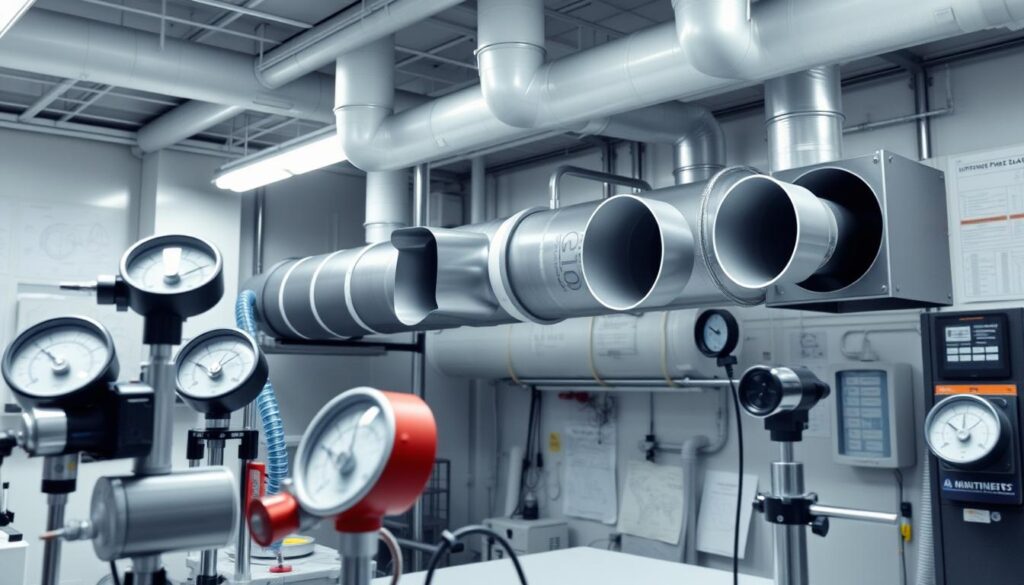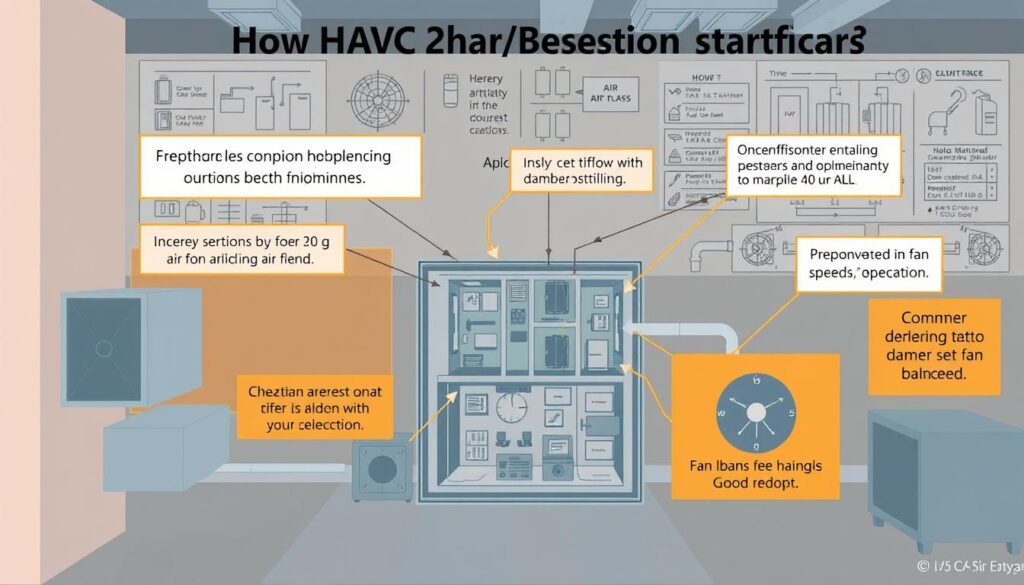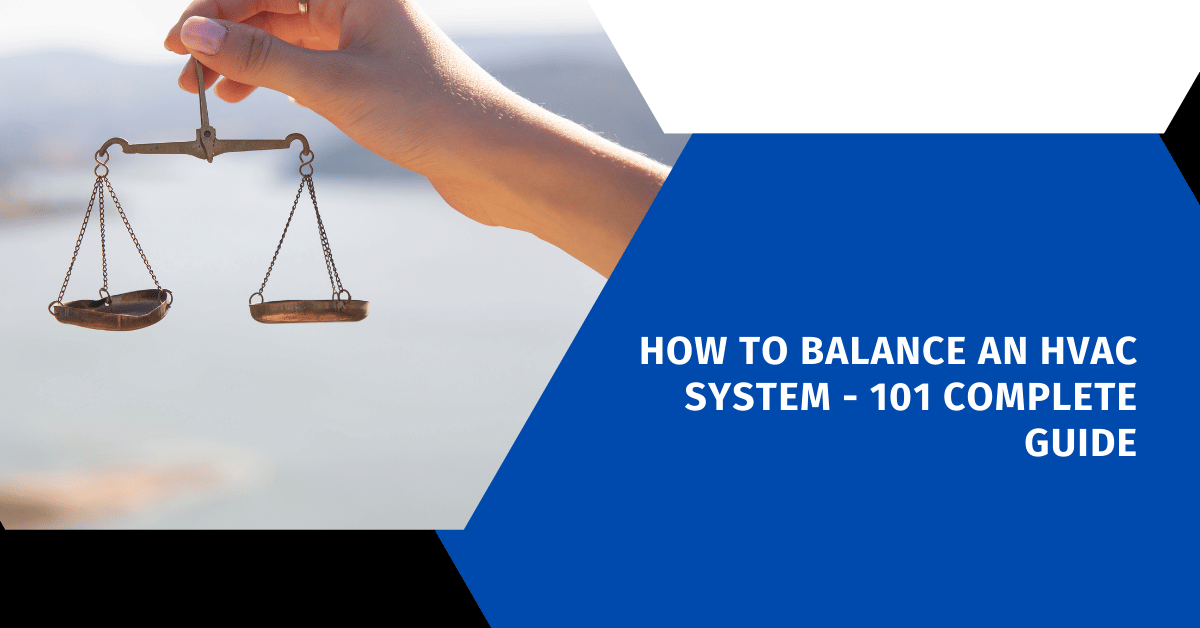Affiliate Disclosure
HVAC Guide Guys is a participant in the Amazon Services LLC Associates Program, an affiliate advertising program designed to provide a means for sites to earn advertising fees by advertising and linking to Amazon.
How to Balance an HVAC System? HVAC air balancing is key for those who want to get the most out of their heating and cooling. This guide will show you how to fix airflow problems. This way, your home will stay cozy all year.

Are you tired of uneven temperatures in your home? Want to find a way to make your home comfortable everywhere? Learning how to balance your HVAC system is the answer. It helps keep your home at a consistent temperature in every room.
Getting your air balanced isn’t just about feeling comfortable. It also makes your system work better and can lower your energy bills. With these tips, you can make your HVAC system work like a pro.
Key Takeaways
- Master the fundamentals of HVAC air balancing
- Identify signs of uneven air distribution
- Learn professional techniques for optimal airflow
- Understand the impact of balanced HVAC systems on energy efficiency
- Discover tools and methods for accurate air measurement
Table of Contents
Understanding HVAC Air Balancing Fundamentals
Your home’s comfort is more than just an HVAC system. Balancing your residential HVAC system is key to a perfect indoor space. It makes sure each room gets the right air, boosting comfort and saving energy.
HVAC airflow adjustment is a detailed process. It changes how your heating and cooling system works. It’s not just about turning it on and hoping for the best.
What is Air Balancing?
Air balancing is a special technique. It measures and adjusts air flow in your home’s ductwork. The aim is to have even temperatures in all rooms. This includes:
- Measuring air volume in different rooms
- Identifying airflow restrictions
- Adjusting dampers and vents
- Ensuring optimal air circulation
Why Balance Matters for Your HVAC System
Proper HVAC system balancing brings many benefits:
- Improved comfort with consistent temperatures
- Reduced energy consumption
- Extended HVAC system lifespan
- Better indoor air quality
Key Components in Air Distribution
Successful HVAC airflow adjustment depends on knowing key parts:
- Ductwork design
- Damper positioning
- Return air systems
- Supply and return registers
By understanding these basics, you can make your home’s heating and cooling better. This ensures comfort in every room.
Explore Our HVAC Shop
Looking for top-rated HVAC tools, parts, and accessories? Visit our shop and find the perfect solution for your needs.
Visit the ShopSigns Your HVAC System Needs Balancing
Spotting an unbalanced heating and cooling system early can prevent expensive fixes and keep your home comfy. A well-balanced HVAC system ensures even air flow in your home.
Look out for these key signs that your HVAC system needs a pro’s touch:
- Dramatic temperature variations between rooms
- Persistent hot or cold spots in different areas of your home
- Unusually high energy bills without explanation
- Weak airflow from certain vents
- Uneven cooling or heating across different floors
“Your HVAC system should provide consistent comfort, not create temperature battlegrounds in your home.”
Balancing your heating and cooling systems is more than tweaking thermostats. It’s about checking your home’s air flow network. Rooms that are way too hot or cold suggest airflow problems that need a pro’s look.
Common signs of poor HVAC zoning balance include:
- Second-floor rooms feeling much warmer than ground-floor spaces
- Noticeable temperature differences between adjacent rooms
- Rooms far from the central unit experiencing minimal air circulation
Fixing these issues quickly can make your home more comfortable, cut down on energy use, and help your HVAC system last longer.
Explore Our HVAC Shop
Looking for top-rated HVAC tools, parts, and accessories? Visit our shop and find the perfect solution for your needs.
Visit the ShopEssential Tools and Equipment for HVAC Balancing
Doing HVAC balancing yourself needs the right tools. Whether you’re a homeowner or want to be an HVAC tech, knowing the key tools is important. It helps you adjust dampers with confidence and precision.
To balance an HVAC system, you need special tools. These tools help measure and improve airflow. Both pros and DIY folks use some of the same tools, but the complexity can differ.
Manual Testing Tools
- Handheld Anemometer: Measures air velocity and volume at individual vents
- Thermometers for temperature differential measurements
- Pitot tubes for precise airflow readings
- Differential pressure gauge
Digital Measurement Devices
- Digital manometers with high accuracy
- Infrared temperature guns
- Smart airflow measurement devices with smartphone connectivity
- Wireless environmental monitoring systems
Safety Equipment
- Protective eyewear
- Work gloves
- Dust masks
- Non-conductive ladder
When you do HVAC balancing yourself, choose quality tools for accurate readings. While pro-grade tools can be pricey, there are affordable options for homeowners. These are great for manual damper adjustment.
How to Balance an HVAC System
Balancing your HVAC system is key for comfort and saving energy. It ensures air flows evenly in your home. With the right techniques, you can make your system work better.
Begin by checking your HVAC system thoroughly. Look at each room’s temperature and air flow. Use a digital airflow meter to see how air is moving. This step helps you know where to make changes.
- Check all supply and return air vents
- Measure room temperatures with a digital thermometer
- Inspect ductwork for possible blockages
- Evaluate damper positions in your duct system
Then, adjust dampers carefully. Dampers control air volume in specific zones. Look for the rectangular metal plates in your ductwork. By tweaking these, you can balance air flow and temperatures in different rooms.
Important steps in balancing your HVAC include:
- Find rooms with uneven temperatures
- Find the right duct dampers
- Make small adjustments
- Check room temperatures after each change
- Keep a record of your changes
Remember, balancing your HVAC system takes time and patience. Small, careful changes will give you the best results. If you’re facing big challenges or your system is complex, getting help from a professional HVAC technician might be best.
Understanding Dampers and Their Role
Dampers are key parts of your HVAC system. They control and direct airflow in your home. These valve-like fixtures are placed in ductwork branches. They let you adjust airflow for better heating and cooling.
Improving your home’s comfort and energy use starts with dampers. They act like gatekeepers, controlling air flow. This lets you adjust HVAC airflow in different areas of your home.
Types of HVAC Dampers
- Manual Dampers: Need direct physical control
- Motorized Dampers: Controlled by electronics
- Backdraft Dampers: Stop air from flowing back
- Volume Control Dampers: Adjust air volume precisely
Proper Damper Adjustment Techniques
Adjusting dampers right involves a few steps:
- Find the damper in the ductwork
- Check its current position
- Slowly adjust the blade angle
- Watch how room temperature changes
- Make small adjustments as needed
Common Damper Issues
| Issue | Potential Cause | Solution |
|---|---|---|
| Stuck Dampers | Dust buildup | Clean and lubricate |
| Uneven Airflow | Wrong adjustment | Adjust damper settings again |
| Mechanical Failure | Wear and tear | Replace broken parts |
Learning to adjust dampers can greatly improve your HVAC system. It ensures consistent comfort and might lower energy bills.
Air Flow Testing and Measurement Methods
Getting accurate airflow tests is key for balancing your home’s HVAC system. Professional HVAC techs use advanced methods to check and improve your home’s air flow.

- Smoke Pencil Testing: Shows air movement and finds blockages or uneven air flow
- Digital Manometer Measurements: Gives exact air pressure readings
- Face Velocity Testing: Checks air speed at vents
Your HVAC system’s performance relies on accurate measurements. Technicians follow a detailed testing process:
- Do an initial system check
- Measure current air flow rates
- Compare with manufacturer specs
- Find areas that need adjustments
Now, advanced digital tools track airflow in real-time. These tools can spot even small imbalances that affect efficiency.
Accurate airflow measurement is the foundation of a well-balanced HVAC system.
Knowing these testing methods helps your HVAC system work at its best. This ensures your home stays comfortable all the time.
Explore Our HVAC Shop
Looking for top-rated HVAC tools, parts, and accessories? Visit our shop and find the perfect solution for your needs.
Visit the ShopProfessional HVAC Balancing Services vs DIY
Choosing between professional HVAC balancing and DIY needs careful thought. Your home’s comfort and energy use depend on this choice.
Cost Comparison Analysis
Professional HVAC balancing costs $750 to $2,000 for a single-family home. DIY can save money but also risks.
| Service Type | Estimated Cost | Complexity |
|---|---|---|
| Professional HVAC Balancing | $750 – $2,000 | Low Personal Effort |
| DIY HVAC Balancing | $100 – $500 | High Personal Effort |
When to Call a Professional
Call a pro for these situations:
- Complex HVAC systems
- Older homes with tricky ductwork
- Constant temperature issues
- Limited tech knowledge
DIY Limitations
DIY hvac balancing has big limits. Without the right tools and skills, you might:
- Get airflow wrong
- Adjust dampers wrong
- Damage the system
- Void warranties
Pro tip: When unsure, get a professional HVAC tech for best results.
Improving HVAC Efficiency Through Balancing
Balancing your heating and cooling systems is key to better performance and energy use. Uneven airflow makes your system work harder and use more energy. This can raise your bills and wear out your equipment.
To boost your HVAC’s efficiency, follow these steps:
- Optimizing airflow distribution across different rooms
- Reducing system workload and energy consumption
- Minimizing temperature variations
- Extending equipment lifespan
Good air balancing does more than save energy. It also makes your home more comfortable by:
- Uniform temperature regulation
- Reducing hot and cold spots
- Enhancing indoor air quality
Professional HVAC technicians can fine-tune your system for better performance. They use special techniques like damper adjustments and airflow tests.
Effective air balancing can reduce energy consumption by up to 20% and significantly improve overall system efficiency.
| Balancing Method | Energy Savings | Comfort Improvement |
|---|---|---|
| Damper Adjustment | 10-15% | High |
| Comprehensive Air Balancing | 15-20% | Very High |
| Regular Maintenance | 5-10% | Moderate |
Getting professional HVAC balancing is a wise choice. It saves energy, cuts costs, and keeps your home cozy.
Common Air Balancing Mistakes to Avoid
Residential HVAC system balancing needs precision and careful attention. Even experienced homeowners can face challenges with hvac air balancing techniques. Knowing common mistakes helps keep your system running well and avoids inefficiencies.

Professional HVAC technicians know air balancing is complex. Many homeowners underestimate its importance. Several critical errors can harm your system’s efficiency and comfort.
Incorrect Damper Settings
Damper adjustments are key for proper air distribution. Wrong settings can lead to big problems:
- Uneven temperature zones in your home
- Increased energy consumption
- Reduced system performance
- Potential premature equipment wear
Neglecting Return Air Balance
Return air balance is often overlooked but is vital. Inadequate return airflow can:
- Create negative pressure in living spaces
- Reduce overall system efficiency
- Cause increased dust and air quality issues
- Force your system to work harder
Poor Documentation
Tracking your hvac air balancing techniques is key for long-term system maintenance. Without proper documentation, you’ll struggle to:
- Track historical system performance
- Identify recurring issues
- Maintain consistent comfort levels
- Plan future maintenance effectively
Avoiding these common mistakes ensures your HVAC system runs efficiently. This provides consistent comfort and saves energy.
Maintaining Balanced Airflow Year-Round
Keeping your HVAC system balanced all year needs careful planning and regular checks. It’s not just a one-time job. It’s an ongoing task that changes with the seasons and your home’s needs.
To keep your HVAC system in balance, follow these important steps:
- Do seasonal system checks
- Change damper settings with temperature changes
- Keep air filters clean
- Watch airflow in different zones
Seasons bring their own challenges. Winter and summer are hard on your HVAC system. It works extra hard to keep your home at the right temperature.
Smart technology makes HVAC care easier. Modern zoning systems with smart thermostats adjust airflow automatically. This cuts down on manual work and boosts system efficiency.
Regular maintenance stops problems before they start. A routine inspection schedule helps catch issues early. This saves energy and makes your HVAC system last longer.
“Consistent care is the key to maintaining optimal HVAC performance.” – HVAC Professional Recommendation
Every home is different. What works for one might not work for another. So, it’s important to pay close attention to your home’s specific needs.
Explore Our HVAC Shop
Looking for top-rated HVAC tools, parts, and accessories? Visit our shop and find the perfect solution for your needs.
Visit the ShopSeasonal Adjustments for Optimal Performance
Balancing heating and cooling systems is key throughout the year. Your HVAC zoning balance keeps your home comfortable with the seasons. Learning to adjust your system can boost energy efficiency and performance.
Different seasons need different HVAC strategies. Here are some tips to get the most out of your system:
- Summer Preparation
- Clean air conditioning coils
- Check refrigerant levels
- Adjust dampers for maximum cooling efficiency
- Winter Preparation
- Inspect heating elements
- Lubricate moving parts
- Seal possible air leaks
“Proactive seasonal maintenance can reduce energy costs by up to 15%” – HVAC Energy Efficiency Association
Temperature changes need careful hvac zoning balance. Your system’s dampers must be adjusted to ensure proper air flow in different home areas.
| Season | Key Adjustment | Expected Benefit |
|---|---|---|
| Summer | Lower return air resistance | Enhanced cooling efficiency |
| Winter | Increase return air flow | Improved heating performance |
By making these seasonal changes, you’ll keep your home cozy. You’ll also make your HVAC system work better.
Conclusion
Learning to balance your HVAC system is key for a cozy and energy-saving home. Knowing how air moves and using smart balancing methods can make your system work better. This also cuts down on energy use.
To boost your HVAC’s efficiency, keep a close eye on it and make adjustments as needed. Fixing airflow, tweaking dampers, and solving problems can make a big difference. You’ll see better temperature control, less wear on your system, and maybe even lower bills.
Whether you do it yourself or get help from a pro, you now know the basics. Keeping up with maintenance, testing, and tweaking will keep your system running smoothly all year.
A balanced HVAC system is a smart choice for your home’s comfort and future. By using the tips from this guide, you can enjoy a more comfortable home. Plus, you’ll get the most out of your system’s energy efficiency.

